Understanding Data Sufficiency questions from the Data Insights section on the GMAT Focus can sometimes feel like solving a puzzle where you don’t have all the pieces. It’s common to find these questions tricky and often a bit frustrating.
If you’re feeling overwhelmed, you’re not alone. Many GMAT aspirants struggle with this unique question type because solving it requires knowledge and strategy. Those familiar with the old GMAT might remember that this question type was earlier tested in the Quantitative reasoning section of the exam, but has been shifted to the Data Insights section since the introduction of the GMAT Focus Edition.
Are you looking for clear guidance and practical strategies to better understand this question type? You’ve come to the right place.
In this blog, we’re going to simplify Data Sufficiency questions for you. We’ll start by explaining what these questions are and why they’re important. Then, we’ll show you a typical example to help you understand what to expect on the test. Most importantly, we’ll share expert GMAT tips and techniques to boost your confidence and improve your skills in tackling these questions effectively.
By the end of this blog, you’ll have all the tools you need to approach Data Sufficiency questions with confidence.
In this blog, we will look at:
Understanding Data Sufficiency Questions
- Structure of Data Sufficiency Questions
- Types of Data Sufficiency Questions
- Concepts Tested in Data Sufficiency Questions
- Key Skills for Solving Data Sufficiency Questions
How Do We Solve Data Sufficiency Questions?
- Strategy for Data sufficiency Questions
- AD/BCE Approach for Data Ssufficiency Questions
- Let’s Solve a Data Sufficiency Questions
- Step-by-Step Solving Process
Strategic Approaches to Tackle Data Sufficiency Questions
Common Pitfalls in Data Sufficiency Questions
- Misinterpreting the Questions
- Over-calculating or Under-calculating
- Ignoring Information or Assuming Extra Information
Grab your free copy of ‘Demystifying GMAT FE’
Understanding GMAT Focus Data Sufficiency Questions
Data Sufficiency Questions have found a new home in the Data Insights section of the GMAT Focus exam. This format tests not just your mathematical prowess but also your ability to critically assess how much information is sufficient to answer the actual question. Unlike traditional math questions that offer a straightforward numerical answer, Data Sufficiency questions challenge you to decide if the provided information is enough to answer a question.
Typical Data sufficiency answer options might include choices like:
- Statement (1) alone is sufficient, but Statement (2) alone is not sufficient.
- Statement (2) ALONE is sufficient, but statement (1) alone is not sufficient.
- Both statements TOGETHER are sufficient, but NEITHER statement ALONE is sufficient.
- EACH statement ALONE is sufficient.
- Statements (1) and (2) TOGETHER are NOT sufficient.
This consistent format means that your focus should be on analyzing and interpreting the statements presented in the question to accurately judge their sufficiency.
For many students, Data Sufficiency questions are one of the most challenging parts of the Data Insights section. GMAT Data Sufficiency questions are unique and require a different approach compared to other Data Insights questions. Gaining a deep understanding of Data Sufficiency questions is the best way to do well on the GMAT Focus. By honing your skills and adopting effective strategies, you can tackle these questions more confidently and boost your score in the Data Insights section.
Structure of Data Sufficiency Questions
There are three parts in a DS question. All parts will be presented at once in the order shown below.
• Question Stem (Optional) and Actual Question.
• 2 Statements
• 5 Default Answer choices.
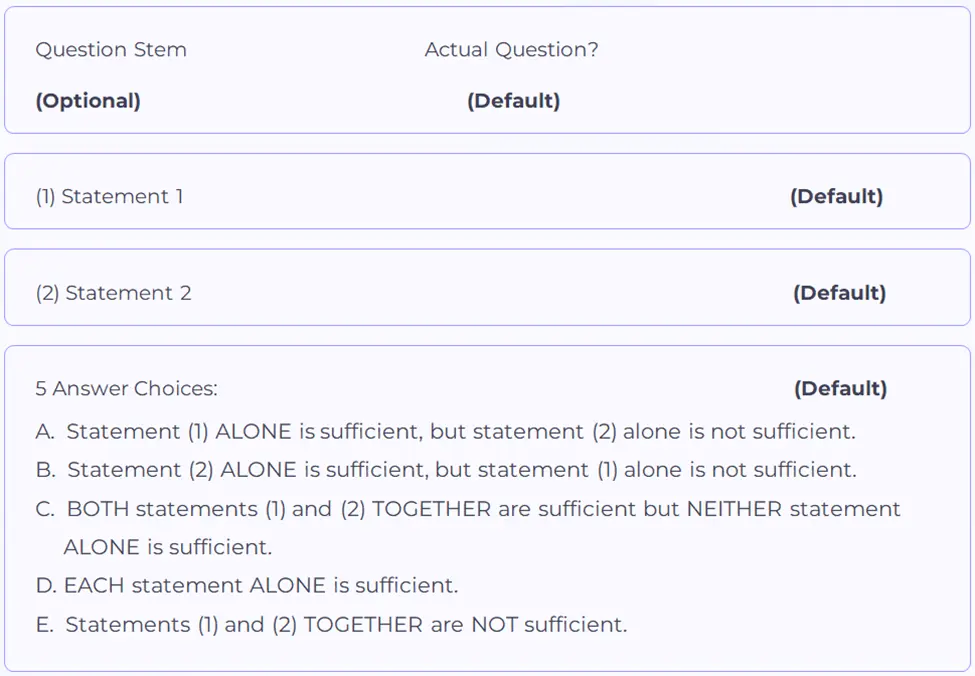
Each question begins with an optional question stem and an actual question that sets up the problem or scenario you need to analyze. It’s critical to carefully read and understand the question stem, as this helps you identify exactly what information is required.
Following the question stem are two statements, labeled (1) and (2). Your task is to evaluate whether the information in each statement, on its own or combined with each other, is enough to answer the question.
Based on your analysis, you’ll then need to select one of the five answer options.
Let’s look at an actual example:
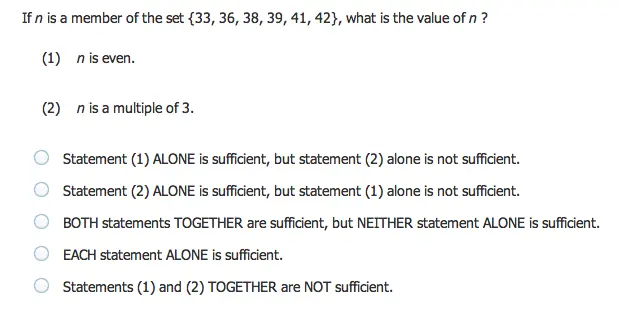
In this case,
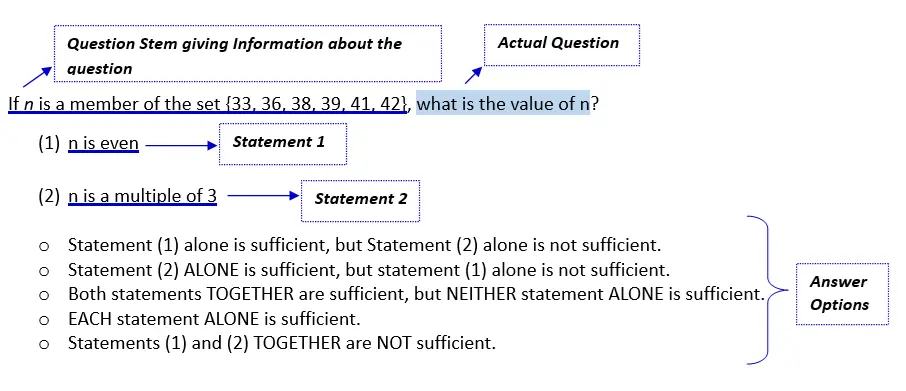
Types of Data Sufficiency Questions
There are two types of DS Questions:
I. Value DS questions
In this question type, we need to find one unique numerical value for the given unknown.
There are a few key phrases that will help you identify this question type:
- “What is the value of x”
- “How much…”
- “How many…”
Concepts Tested in Data Sufficiency Questions
Based on the concepts tested, DS Question fall under two broad categories:
Math-based Questions: These questions could be testing your skills on math concepts such as exponent and roots, percentages, ratios and proportion, rates, simple algebra, linear or quadratic equations, set theory, permutations and combinations, probability and statistics. In other words, you could be tested on concepts you have learned in the Quantitative Section of the GMAT Focus.
Non Math-based Questions: These could be testing your basic reasoning skills and could seem quite similar to the Critical Reasoning questions in the Verbal Section of the GMAT Focus.
Key Skills for Solving Data Sufficiency Questions
Apart from knowing the math concepts mentioned above, mastering Data Sufficiency questions on the GMAT is about honing a unique set of skills that blend critical thinking, math expertise, and logical reasoning.
Critical Thinking: Unlike other questions where the answer must be calculated, here you must decide if you have enough data to even make a calculation. This involves a careful analysis of each statement provided.
Does one statement answer the question on its own, or do you need both?
This is where your critical thinking is crucial. It’s about understanding whether what’s presented is enough.
Grab your free copy of ‘Demystifying GMAT FE’
How do we solve Data Sufficiency Questions?
If you are in the early stages of your GMAT preparation, it is crucial to adhere to a systematic approach for solving Data Sufficiency questions. As you advance and master this question type, you can refine your approach.
Strategy for DS questions
When approaching Data Sufficiency questions, it’s crucial to keep two key principles in mind:
a. Focus on Sufficiency, Not Proof: The goal is not to prove the given two statements but to assess whether they are sufficient (either individually or together) to answer the actual question.
b. Stay within the Scope of the actual question: Always be clear about what is asked in the question and what information is given. This clarity ensures you stay within the scope of the question.
To effectively tackle DS questions, follow the KNE strategy:
Know: Understand what information is provided in the question stem.
Need: Identify what needs to be found to answer the actual question.
Evaluate: Use the given statements to evaluate the bridge between what you know and what you need.
AD/BCE Approach for DS Questions
Let’s have a look at this approach.
Case 1:
1. Solve the question using the first statement alone.
If Statement 1 alone is sufficient, eliminate answer choices B, C, and E, leaving either A or D.
2. Solve the question using the second statement alone.
If Statement II alone is sufficient, the answer is D or A.
Case 2:
1. Solve the question using the first statement alone.
If Statement 1 alone is not sufficient, eliminate answer choices A and D, and your answers are B, C, or E.
2. Solve the question using the second statement alone.
• If Statement II alone is sufficient, the answer is B; otherwise, it’s either C or E.
• If Statement II alone is not sufficient, consider both statements together.
• If both statements together are sufficient, the answer is C or E.
This approach provides a systematic way to tackle DS questions. Let’s illustrate it with a flowchart below:
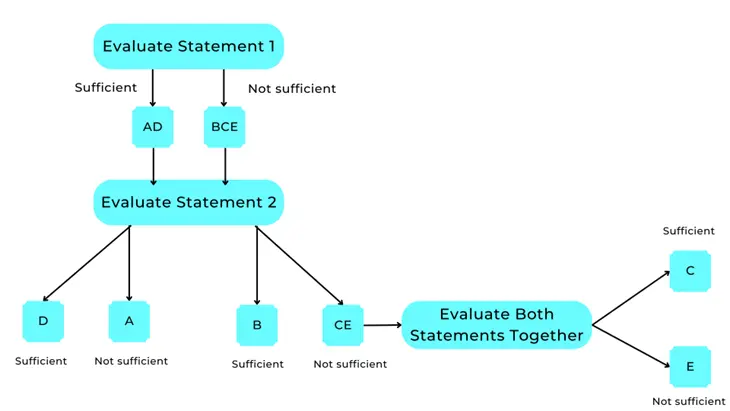
Let’s solve a question using this approach and the strategy!
Let’s solve a Data Sufficiency Question
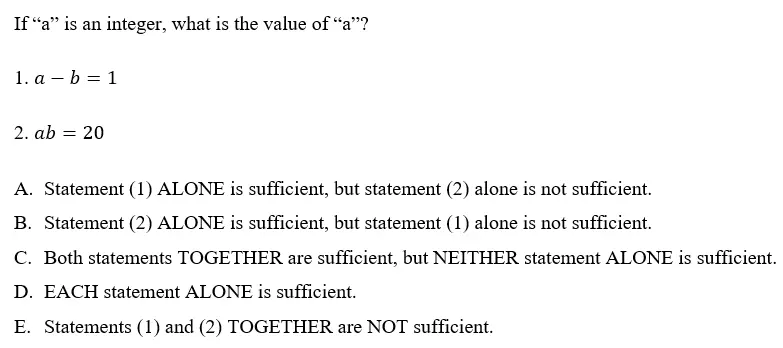
Let’s break down the explanation into a clear and methodical format that incorporates the AD/BCE approach and the KNE (Know-Need-Evaluate) strategy.
Know:
“a” is an integer. This means “a” can be any whole number, including positive numbers (1, 2, 3…), zero (0), and negative numbers (-1, -2, -3…).
Need:
The specific value of “a”. Since this is a Value – Data Sufficiency question, we’re looking for a unique value of “a”.
Evaluating the Statements Using AD/BCE
Statement 1: a−b=1
Evaluate: This statement tells us that “a” is exactly one more than “b”. However, without any information about “b”, “a” could be any integer. For instance, if
b=10, then
a=11; or if
b=0, then
a=1.
The key point here is that “a” will always be greater than “b”, but without a specific value for “b”, we cannot determine a unique value for “a”.
Conclusion: Statement 1 is insufficient data for us to find the value of a.
Action: As per the AD/BCE approach, eliminate answer choices A and D. We’re now left with B, C, or E.
Statement 2: ab=20
Evaluate: This statement indicates that the product of “a” and “b” equals 20. But again, without specific constraints on “b”, “a” could take on multiple values. “b” could also be a fraction, which complicates things further.
For example, if b=1, then
a=20
or if b= 1/20, then
a=400.
The variety of possible values for “a” means we cannot find a unique value.
Conclusion: Insufficient.
Action: Eliminate answer choice B. Our options are now C or E.
Both Statements Together
Statement 1: a-b=1, i.e., a= b+1
Statement 2: ab=20
Let’s combine information from Statement 1 in Statement 2.
ab = 20
That is, a x b = 20
we know from Statement 1 that a = b + 1
So, (b+1) x b = 20
When we solve this equation, we see that b can either be -5 or 4.
If b = -5, then “a” will be -4.
and if b = 4, then “a” will be 5.
Since we end up with two different values for “a”, we still do not have a unique value.
Conclusion: Even together, the statements are insufficient.
Final Answer: E
Step-by-Step Solving Process
Now that we’ve successfully navigated a Data Sufficiency question using the correct approach and strategy, let’s break down each step of the process so that you can tackle any Data Sufficiency question on the GMAT, regardless of its difficulty.
Let’s dive into each step to see how you can apply these strategies effectively.
Step 1: Understand the Question (Know)
- Goal: Begin by carefully reading the question stem to fully grasp what is being asked. This clarity is crucial as it guides the entire evaluation process.
- Action: Identify the specific information or conclusion needed. This is what you “Know”.
Step 2: Clarify What You Need (Need)
- Goal: Determine exactly what you need to find out to answer the question correctly. This step defines the objective of your evaluation.
- Action: Outline the requirements or conditions that must be met to answer the question. This is what you “Need”.
Step 3: Evaluate the First Statement (Evaluate)
- Goal: Assess if the first statement alone provides sufficient information to meet the requirements identified in Step 2.
- Action:
- Analyze the statement without considering any other information.
- If it’s sufficient to answer the question, apply the AD/BCE approach. Eliminate answer choices B, C, and E, leaving A or D as potential correct answers.
Step 4: Evaluate the Second Statement (Evaluate)
- Goal: Similarly, evaluate the sufficiency of the second statement independently of the first.
- Action:
- If the second statement alone provides a sufficient answer:
- If the first statement was also sufficient (from Step 3), the answer is D (each alone is sufficient).
- If only the second statement is sufficient, and the first was not, eliminate A and D, and consider B as the correct answer.
Step 5: Evaluate Statements Together (If Needed)
- Goal: If neither statement alone is sufficient, assess whether combining them fills the gaps and provides a definite answer.
- Action:
- Combine the insights from both statements:
- If they together answer the question, choose C.
- If they still don’t provide enough information, the correct answer is E.
Step 6: Final Decision
- Goal: Conclude based on the evaluations from previous steps.
- Action: Select the answer that best fits the sufficiency of the information provided by the statements, using the AD/BCE approach to guide your final decision.
By following this structured process, you can methodically evaluate the sufficiency of information provided in Data Sufficiency questions. This method not only improves your accuracy but also enhances your efficiency, allowing for better time management during the exam.
Strategic Approaches to Tackle Data Sufficiency
To effectively master Data Sufficiency questions on the GMAT, embracing strategic approaches is essential. Strategies like the Elimination method, Plugging in numbers, and recognizing sufficient information are designed to help you evaluate the sufficiency of the given information accurately and guide you to the correct answer.
The Elimination Method
This approach involves a systematic review of each statement provided in the question, followed by strategic elimination of answer choices that are clearly incorrect based on the data’s sufficiency.
Steps to Apply the Elimination Method:
Evaluate the first statement independently to determine if it alone provides enough information to answer the question. If it does, you can eliminate all answer choices that suggest you need more information.
Evaluate the second statement independently, regardless of the sufficiency of the first. If the second statement alone provides enough information, eliminate the choices that do not acknowledge its sufficiency.
By methodically evaluating each statement, you focus on narrowing down the answer choices effectively, enhancing decision-making clarity and accuracy.
Benefits of the elimination method:
Efficiency: Saves time by reducing the number of possibilities you need to consider.
Clarity: Provides a clear pathway to determine the correct answer by systematically rejecting incorrect options.
Accuracy: Reduces the risk of misinterpretation by focusing on the sufficiency of each statement on its own merits.
This strategic approach is especially effective for complex Data Sufficiency problems where the relationships between variables are not immediately obvious. By breaking down the analysis into more manageable steps, you can tackle even the most challenging questions with confidence.
Plugging in Numbers
This hands-on approach involves substituting specific values into the variables provided in the statements. By testing different scenarios, you can assess the consistency of the information and determine its sufficiency.
Effective Use of Plugging in Numbers:
Identify relevant values for the question, considering different types like positive numbers, negative numbers, and fractions.
Substitute these values into the given statements and observe if they consistently lead to a definitive answer.
Evaluate the outcomes for each substitution to confirm if the information is sufficient across all tested scenarios.
Benefits of the plugging in numbers method:
Clarity in complex scenarios: This approach can simplify complex algebraic expressions or abstract concepts by turning them into concrete examples.
Revealing hidden constraints: By testing extreme values or unusual cases, you can uncover implicit conditions or limitations in the given information that might not be immediately obvious.
Confirming or refuting sufficiency: This strategy directly tests the robustness of the given statements, helping you confidently decide whether the information provided is adequate.
By applying this method, you gain a clearer understanding of how the given information interplays with the question, enhancing your ability to judge its sufficiency accurately. Plugging in numbers not only aids in visualizing the problem but also strengthens your overall problem-solving strategy in Data Sufficiency questions.
Grab your free copy of ‘Demystifying GMAT FE’
Recognizing Sufficient Information
Developing an acute awareness of common patterns and scenarios where the provided information is typically sufficient can significantly speed up your decision-making process.
Strategies to Recognize Sufficient Information:
Learn common sufficiency patterns, such as specific equation forms or relationships that generally provide definitive solutions.
Apply quick checks for sufficiency when you review a statement to see if it directly answers the question or establishes a necessary relationship.
Minimize unnecessary calculations by confirming sufficiency through recognition, thus saving time and mental energy.
Examples of recognizing sufficient information::
Comparison questions: If the question involves comparing two values and one of the statements clearly establishes one value as greater, less, or equal, you can promptly conclude that the information is sufficient.
Specific value questions: When asked for a specific numeric value, if a statement provides an exact calculation or defines the value uniquely (such as stating a geometric property that determines a shape’s dimensions), this is typically sufficient.
Developing the skill to recognize when information is sufficient helps streamline your decision-making process in Data Sufficiency questions. This approach not only enhances your test-taking speed but also improves your overall accuracy by reducing the likelihood of over-analyzing or misinterpreting data. By practicing with a variety of Data Sufficiency problems, you can refine this skill, making your GMAT preparation more effective and your exam performance more proficient.
Common Pitfalls in Data Sufficiency Questions
When tackling Data Sufficiency questions on the GMAT, being aware of common pitfalls can greatly enhance your accuracy and help you avoid unnecessary errors. Three frequent mistakes to watch out for are making incorrect assumptions, over-calculating, and misinterpreting the provided information. Understanding these common errors and practicing regularly can improve your precision and enhance your overall test-taking strategy. Each pitfall is explored in greater detail in the following sections to help you navigate these challenges effectively.
Misinterpreting the Questions
Understanding the nuances of Data Sufficiency questions on the GMAT is crucial to avoid misinterpretation, which can lead to incorrect conclusions and answers. Here’s a clearer breakdown of how to approach these questions effectively:
Read Thoroughly
Ensure you fully comprehend both the question stem and the statements provided. This is fundamental to avoid misinterpreting what the question is asking.
Understand the Question Type
Data Sufficiency questions are unique in that they require you to assess if the information given is enough to answer the question—not to solve for a specific numerical answer. Recognizing this will help shift your focus towards evaluating the sufficiency of the information rather than trying to find a definitive solution.
Identify What’s Required
It’s crucial to differentiate between necessary and irrelevant information. This distinction will help you focus on the relevant data and accurately assess its sufficiency to answer the question.
Practice Regularly
Engage with a variety of Data Sufficiency questions to improve your understanding and accuracy. Focused practice on interpreting what each question specifically asks will enhance your ability to avoid common misinterpretations.
Over-calculating or Under-calculating
Finding the right balance between over-calculating and under-calculating is essential to excel in Data Sufficiency questions on the GMAT. Here’s how to approach these challenges effectively:
Understanding the Goal
Data Sufficiency questions are designed to assess whether you have enough information to answer a question, not to perform complex calculations. The goal is to determine the sufficiency of the data, not necessarily to find an exact numerical answer.
Avoid Over-Calculating
Issue: Getting caught in detailed computations or trying to find exact values when it’s not required can waste valuable time and distract from the main objective.
Strategy: Focus on assessing whether the given information is sufficient to answer the question. Avoid deep calculations that lead you away from this primary goal.
Beware of Under-Calculating
Issue: Insufficient analysis or failing to perform necessary calculations can lead to premature conclusions about the insufficiency of the data.
Strategy: Ensure you do enough calculation to logically connect the information to the question. Some problems may require a certain level of calculation to determine if the data logically suffices.
Finding the Balance
Approach: Perform enough calculations to confidently assess if the provided statements conclusively answer the question, but refrain from fully solving the problem if it’s not required.
Outcome: By focusing on evaluating the sufficiency of the information, you can save time, avoid common pitfalls, and achieve more accurate conclusions, enhancing your performance on the exam.
Ignoring Information or Assuming Extra Information
When tackling Data Sufficiency questions on the GMAT, it’s crucial to handle the information provided with precision and caution. Here’s how to approach these questions effectively:
Avoid Ignoring Information
In Data Sufficiency questions, every detail in the question stem and provided statements can be crucial. Overlooking relevant data can easily result in inaccurate conclusions and incorrect answers. It’s vital to thoroughly analyze and assess the relevance of each piece of information to ensure you are fully considering what’s presented.
Don’t Assume Extra Information
These questions are designed to evaluate your ability to work with exactly what’s provided—no more, no less. Introducing data or assumptions not explicitly stated can lead to skewed analyses and incorrect conclusions. Stick strictly to the information given, resisting the urge to fill in gaps with unverified data.
Adopt a Focused Analytical Approach
To excel in Data Sufficiency:
- Carefully examine all the information available.
- Avoid discarding any detail before confirming its irrelevance.
- Refrain from assuming information that isn’t given.
Resources to use to ace Data Sufficiency Questions
Practice is key to mastering Data Sufficiency questions and achieving a high score on the GMAT exam. Here are some resources that you can use to practice and improve your skills:
- GMAT™ Official Guide 2023-2024: eBook & Online Question Bank: This guide is a comprehensive resource that includes an eBook and an online question bank, offering a wide range of practice questions and answer explanations covering all sections of the GMAT.
- GMAT™ Official Guide Data Insights Review 2023-2024: eBook & Online Question Bank: Focused on data analysis, this guide provides detailed insights and strategies for handling the data-driven aspects of the GMAT, supplemented by an eBook and an online question bank for targeted practice.
- GMAT™ Focus Official Practice Questions – Data Insights: This set offers specialized practice questions designed to improve skills in interpreting and analyzing data, ideal for mastering the Data Insights sections of the GMAT.
- GMAT™ Focus Official Starter Kit + Practice Exams 1 & 2: A starter kit for new GMAT test-takers, featuring introductory materials, tips, and two full-length practice tests to simulate the actual test experience.
- GMAT™ Focus Official Practice Exams 3 – 6: A continuation of the GMAT practice series, this package includes four additional full-length practice exams, helping candidates to further refine their test-taking strategies and timing.
- GMAT Club: GMAT Club is a popular online community where you can find a wealth of resources, including practice questions, explanations, and discussion forums. Engaging with the GMAT Club community can provide valuable insights and help you refine your problem-solving techniques.
- GMAT Prep Courses: Explore Crackverbal’s specialized GMAT prep courses, such as GMAT Live Online, GMAT Personal Tutoring, and GMAT Fast Track, each designed to enhance your skills in Data Sufficiency questions and other question types.
By dedicating time to practice and utilizing these resources, you can strengthen your Data Sufficiency skills and increase your chances of success in the GMAT exam.
Conclusion
Wrapping up, mastering Graphics Interpretation questions on the GMAT is less about staring at daunting charts and more about decoding the story they tell. Each graph or chart is a narrative of numbers where your analytical prowess, your familiarity with different types of visual data, and those clever interpretation techniques you’ve honed come into play. Be wary of pitfalls like misreading data or overlooking critical information. Employ robust strategies such as systematic analysis and key point verification to navigate through the intricacies of each graph.
Keep your preparation lively and adaptable, and remember that clarity often comes from revisiting the basics or a new angle on the problem. If you find yourself in need of a boost or a different strategy, don’t hesitate to reach out for guidance from a seasoned GMAT tutor. With the right mix of practice and perseverance, you’re not just going to get by Graphics Interpretation questions—you’re going to excel at them.
Are you ready to conquer the GMAT with confidence? Let’s chart the course to success together!

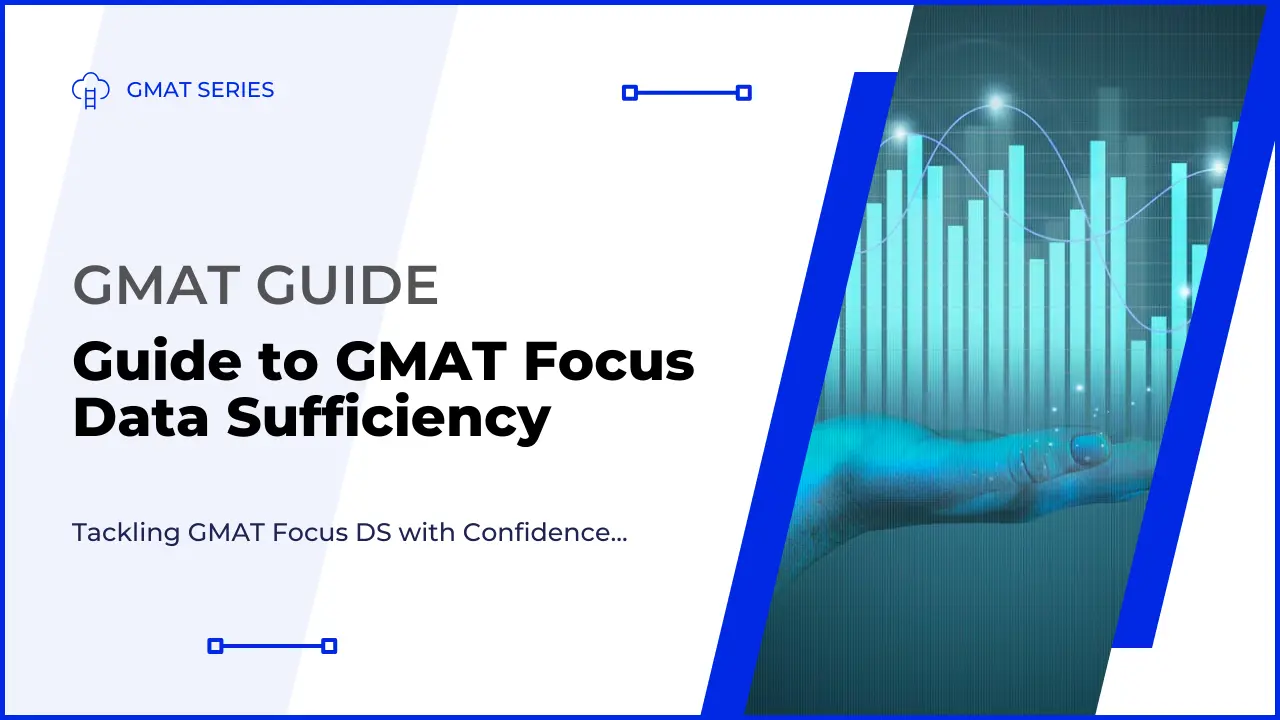



0 Comments